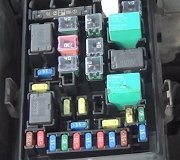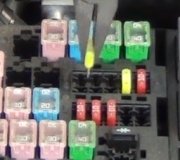Buy the truck you want. There is too much modification needed to switch to a different engine, and way more needed to switch to an engine from a different year.
1996 and newer vehicles have the on-board-diagnostics, version 2, (OBD2), emissions system which has added two oxygen sensors after the catalytic converters to measure their efficiency, and a pump to put the fuel vapor recovery system under pressure to test for leaks. None of that is on the 1995 model. Even if you do not use those systems, you will need the Engine Computer to run the V-8 engine. The flex plates are different because they have rings added with notches, or cutouts, that are read by the crankshaft position sensor to tell the computer when to fire the spark plugs and injectors. Those groups of notches are different between years. If you have a mismatched part, the computer will become confused and the engine will not run.
The Engine Computer that goes with the 2001 engine needs to see the inputs from the oxygen sensors, and it performs tests on the output circuits. When it sees you do not have the right charcoal canister purge valve, and/or the right EGR valve sensor, it will set a diagnostic fault code and turn on the Check Engine light. With that light on, some other self-tests will be suspended, so if a problem develops in one of those circuits, it won't be detected, and you will have no way to know where to start the diagnosis. Left ignored, some of those problems can be very minor, but turn into expensive repairs.
The Engine Computer talks back and forth to the Body Computer, (Central Timer Module), the Transmission Computer, and the Instrument Cluster. You'll need to replace all of those, along with the wiring harness for most of the truck. What you are trying to do equates to installing a Space Shuttle engine into a row boat. There is a lot more involved than just bolting in the wrong part. The Rock Auto web site is a good place to look up parts for both applications and see which ones are different. This is why when you visit the dealer's parts department, they ask you the engine size for things that seem to have no relevance.
You will be adding 150 pounds to the front of the truck. That means the front springs need to be changed to stronger ones that will retain the correct ride height. Chassis ride height is critical for maintaining the suspension and steering system geometry. That is critical for proper tire wear, braking, handling, and steering response. You are not aware of the huge cost of research and development that went into the braking system to make it perfectly balanced, front-to-rear. When a truck is raised or a car is lowered, that adversely affects the stopping ability. You can be sure lawyers and insurance investigators know all about these modifications. They will use it against you in a lawsuit when their client ran the red light and caused the crash. They will convince a jury that you were partly at fault because you were less able to avoid it, and they will be right.
If you were to replace the front coil springs to restore ride height, you still must consider the higher percentage of weight distribution on the front. That means you need to replace the brake system combination valve with one with an internal proportioning valve to reduce the braking power to the rear wheels. If you do not make that switch, the rear wheels will lock up too easily. Most of these trucks came with rear anti-lock brakes, (RWAL), and the dump valve assembly is carefully calibrated for the weight of the truck. You can be sure the other guy's lawyer is going to discover the wrong engine is in your truck. That will cause him to investigate further with much more enthusiasm to find all the parts of the system you did not change.
Your truck may use a rear height-sensing proportioning valve in the brake system. That could be different. You will need to use the transmission that can hold up to the torque of a V-8 engine. Many car and light truck models have two or three different brake systems that were matched to the vehicle. To stop the higher weight safely, you may need to switch to larger diameter rear drums and shoes, or larger front rotors and pads, and larger-diameter calipers.
The only things you have going for you is you will avoid two problems with this being a two-wheel-drive truck. The four-wheel-drives have a common recurring problem with steering wander, and the heavier models can develop a horrendous, unexpected brake pull to one side, after the brakes get hot, if proper procedures are not followed during a brake job. There is a thirty two page service bulletin for that, and the long list of preliminary things to check does not include checking for the wrong engine.
Do not forget about the larger radiator and different fan shroud.
Look at this as an opportunity to trade for the truck you want. If you pursue this project, it will end up with many things not working, and most of the time they end up with a "For Sale As Is" sign in the window. My recommendation, regardless if you want to stick with two-wheel-drive or switch to four-wheel-drive, is look for a Dodge truck starting around 2002 or 2003 with a rack and pinion steering system. You will not have the steering problems that were common on the older models, and you will get the engine you want. After owning only Chrysler products since the 1970's, and fighting the ridiculous over-use of unnecessary technology, I bought my first truck two years ago. That is a 2014 Ram with the 5.7L Hemi. Drive one of those, then see if you want to resume dreaming about this project. You will get twice the comfort, twice the fuel mileage, and much better handling, at a lower cost than what you will have invested in your current truck.
Thursday, April 6th, 2017 AT 5:24 PM



